Pasta Recipes
How to Make the Perfect Tomato-Based Pasta Sauce: A Delicious Guide

How to Make the Perfect Tomato-Based Pasta Sauce: A Delicious Guide
Tomato-based pasta sauces are a staple in many kitchens, bringing rich flavors and a touch of tradition to your favorite pasta dishes. Whether you’re looking to master a classic marinara or experiment with new variations, this guide will take you through everything you need to know to create the perfect tomato-based pasta sauce. Let’s dive into the essentials, step-by-step process, and some secret tips that will elevate your sauce to restaurant-quality right at home.
Visit FoodiesDen for more delicious recipes and cooking tips!
The Basics of Tomato-Based Pasta Sauces
Tomato-based pasta sauces are versatile, pairing well with everything from spaghetti to lasagna. They typically start with a foundation of tomatoes, garlic, onions, and olive oil. The beauty of these sauces lies in their adaptability—you can make them as simple or as complex as you like. The key to perfection is balancing acidity and sweetness, creating a sauce that complements rather than overpowers your pasta.
Choosing the Right Tomatoes
The first step to making a great tomato-based pasta sauce is selecting the right tomatoes. Fresh, ripe tomatoes are ideal for a bright, vibrant sauce. Plum tomatoes like San Marzano are often preferred due to their sweetness and low acidity. If fresh tomatoes are not available, high-quality canned tomatoes can be a great substitute.
Fresh Tomatoes vs. Canned Tomatoes
Fresh tomatoes give a lighter, fresher taste to the sauce, but they require more preparation, such as peeling and seeding. Canned tomatoes, on the other hand, are convenient and pack a punch of concentrated flavor. For a well-rounded sauce, use a combination of both: fresh tomatoes for brightness and canned for depth.
The Secret to a Flavorful Base
A flavorful base is crucial for any good sauce. Start by sautéing onions in olive oil until translucent. Add garlic, being careful not to burn it, as it can turn bitter. For a more complex flavor, add finely chopped carrots and celery, which provide natural sweetness and balance the acidity of the tomatoes.
Building Depth with Herbs and Spices
Herbs and spices are the backbone of a great tomato-based pasta sauce. The classic choice is a mix of basil and oregano. However, don’t be afraid to experiment with thyme, rosemary, or even a bay leaf. For a little heat, add a pinch of red pepper flakes. Remember, fresh herbs should be added towards the end of cooking to preserve their vibrant flavor, while dried herbs can go in early to release their essence.
Balancing Acidity and Sweetness
Tomatoes are naturally acidic, which can make your sauce taste sharp. To balance this, add a teaspoon of sugar or a splash of balsamic vinegar. Be cautious with sugar; a little goes a long way. Alternatively, cooking the sauce slowly helps reduce acidity and develop sweetness naturally.
The Art of Simmering
Simmering is where the magic happens. After adding your tomatoes to the sautéed base, bring the sauce to a gentle boil, then reduce to a simmer. Let it cook for at least 30 minutes to allow the flavors to meld together. Stir occasionally and taste as you go. The longer it simmers, the richer and thicker your sauce will become.
How to Thicken Your Sauce
If your sauce is too watery, there are several ways to thicken it. The simplest method is to let it simmer uncovered so the excess water evaporates. For a richer texture, you can add a spoonful of tomato paste or puree some of the sauce and stir it back in. Another trick is to add a little grated parmesan cheese towards the end of cooking.
Adding Protein and Vegetables
To make your tomato-based pasta sauce heartier, consider adding ground meat like beef, pork, or sausage. Sauté the meat separately, drain the excess fat, and then add it to the sauce. For a vegetarian version, mushrooms, bell peppers, and zucchini are excellent additions that absorb the sauce’s flavors beautifully.
Final Touches for the Perfect Sauce
Before serving, taste your sauce and adjust the seasoning. Add salt, pepper, and maybe a touch more sugar if needed. For a luxurious finish, stir in a knob of butter or a drizzle of high-quality olive oil. This step adds a silky texture and enhances the overall flavor.
Pairing Your Sauce with Pasta
Different pasta shapes work better with different sauces. A thick, hearty sauce pairs well with sturdy shapes like rigatoni or penne, while a lighter, smoother sauce complements delicate strands like spaghetti or linguine. To ensure your sauce clings to the pasta, cook the pasta al dente and toss it directly into the sauce before serving.
Tomato-Based Pasta Sauces for Special Diets
Tomato-based sauces are naturally gluten-free, making them a great choice for those with gluten sensitivities. For a vegan version, simply skip the cheese and meat. You can also use zucchini noodles or spaghetti squash instead of traditional pasta to keep the dish low-carb.

Common Mistakes to Avoid
Even the best cooks make mistakes. Here are a few to watch out for:
- Burning the Garlic: Always add garlic after the onions have softened to avoid burning.
- Over-Salting Early On: Tomatoes reduce as they cook, concentrating their flavors, including salt. Season lightly at the beginning and adjust later.
- Rushing the Simmering Process: The flavors need time to develop, so don’t rush. A good sauce can take anywhere from 30 minutes to several hours.
FAQs
How long should you cook tomato-based pasta sauce?
For the best flavor, cook your sauce for at least 30 minutes. For a richer taste, you can simmer it for up to two hours.
Can I freeze tomato-based pasta sauce?
Yes, tomato-based pasta sauce freezes well. Let it cool completely before transferring it to airtight containers. It can be frozen for up to 3 months.
What can I do if my sauce is too acidic?
If your sauce is too acidic, add a pinch of sugar or a splash of cream to balance it out. Simmering longer can also help mellow the acidity.
Can I use dried herbs instead of fresh ones?
Absolutely. Dried herbs have a more concentrated flavor, so you’ll need less. Add them early in the cooking process to allow them to rehydrate and release their flavors.
Is it necessary to peel tomatoes for sauce?
Peeling is optional. Some prefer it for a smoother texture, but if you don’t mind a bit of texture, you can skip this step.
What’s the best pasta to serve with tomato-based pasta sauces?
Pasta shapes like spaghetti, linguine, and fettuccine work well with smoother tomato sauces. For chunkier sauces, go for pasta with ridges like penne or rigatoni.
Conclusion
Mastering the art of making perfect tomato-based pasta sauces is a rewarding experience. With the right ingredients and a little patience, you can create a sauce that is deliciously rich, balanced, and bursting with flavor. Remember, the best sauce is one that suits your taste, so don’t be afraid to experiment and make it your own. Enjoy your cooking!
For more culinary inspirations and detailed recipes, explore FoodiesDen!
Pasta Recipes
test
test
Pasta Recipes
Creamy Mushroom Pasta Recipes That Are Irresistible
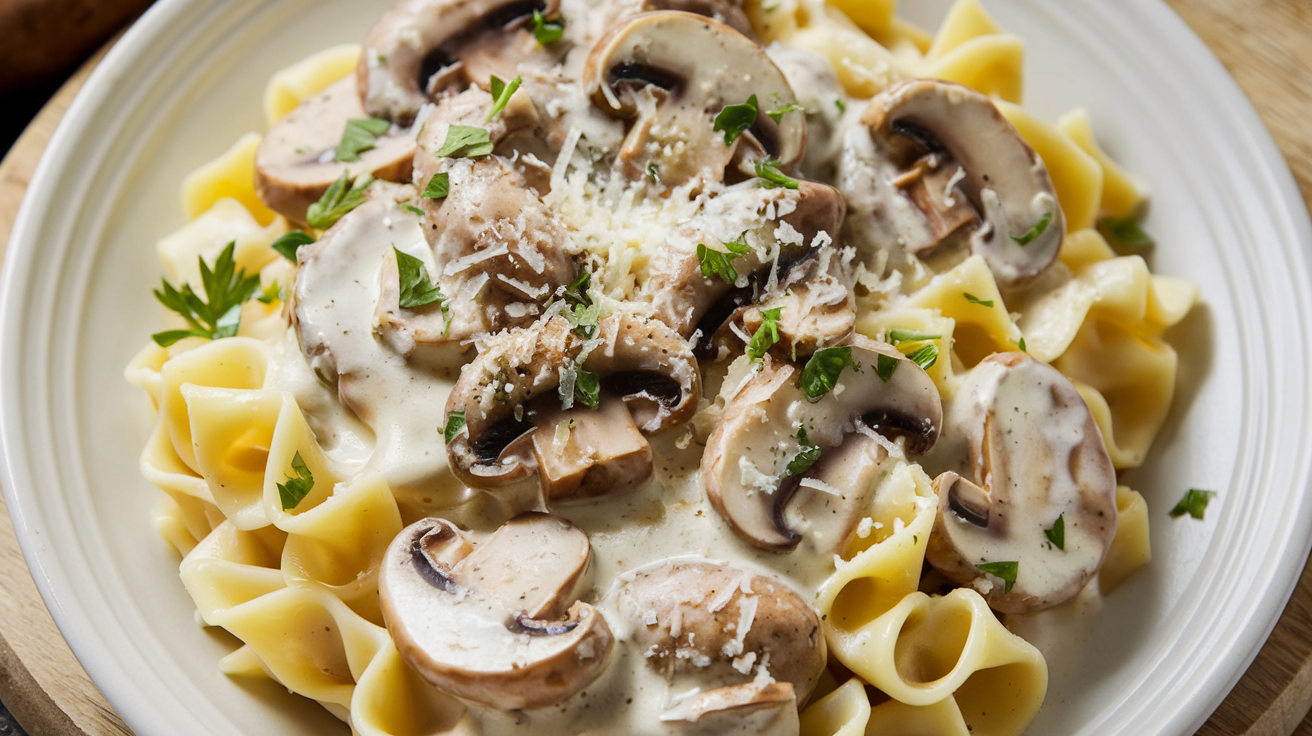
Creamy Mushroom Pasta Recipes That Are Irresistible
Creamy mushroom pasta is a comforting dish that combines rich, earthy flavors with the silkiness of a cream-based sauce. Whether you’re a seasoned cook or just beginning your culinary journey, creamy mushroom pasta is an easy yet indulgent dish that brings a touch of gourmet dining to your home. This article will introduce you to some delicious creamy mushroom pasta recipes that are irresistible, versatile, and perfect for any occasion. So, grab your ingredients and prepare to make a meal that everyone will love!
The Allure of Creamy Mushroom Pasta
Mushrooms are not only packed with nutrients, but they also offer a unique, savory flavor that elevates a dish. When combined with a creamy sauce, the umami notes from the mushrooms blend seamlessly with the richness of cream, butter, and cheese, creating an irresistible flavor profile. Creamy mushroom pasta is versatile and can be tailored to different tastes by adding ingredients like spinach, garlic, or Parmesan. It’s a satisfying dish, ideal for cozy nights in or entertaining guests.
Let’s dive into some delightful creamy mushroom pasta recipes that are sure to impress your family and friends.
Classic Creamy Mushroom Pasta
If you’re looking for a traditional take on creamy mushroom pasta, this classic recipe is the way to go. It’s simple, flavorful, and made with just a few key ingredients.
Ingredients:
- 300g pasta (penne, fettuccine, or spaghetti)
- 250g mushrooms (button, cremini, or a mix of your favorite)
- 2 tbsp olive oil
- 1 tbsp butter
- 2 cloves garlic, minced
- 200ml heavy cream
- 50g Parmesan cheese, grated
- Salt and pepper to taste
- Fresh parsley for garnish
Instructions:
- Cook the pasta in salted boiling water until al dente. Drain and set aside.
- In a large pan, heat olive oil and butter over medium heat. Add the minced garlic and sauté for a minute until fragrant.
- Add the sliced mushrooms to the pan and cook until they become soft and golden brown, about 5-7 minutes.
- Stir in the heavy cream, bring to a gentle simmer, and cook for 3-5 minutes until the sauce thickens.
- Add the Parmesan cheese and stir until melted and combined.
- Season with salt and pepper to taste.
- Toss the cooked pasta into the sauce, ensuring it is fully coated.
- Garnish with fresh parsley and serve hot.
This classic creamy mushroom pasta is incredibly comforting and easy to make. It’s the perfect dish when you’re craving something quick but luxurious.
Creamy Garlic Mushroom Pasta with Spinach
Adding spinach to creamy mushroom pasta not only adds a pop of color but also brings additional nutrients to the dish. The combination of garlic, spinach, and mushrooms creates a well-balanced and hearty meal.
Ingredients:
- 300g fettuccine
- 200g mushrooms, sliced
- 2 cups fresh spinach
- 3 cloves garlic, minced
- 2 tbsp olive oil
- 1 cup heavy cream
- 1/2 cup vegetable broth
- 50g Parmesan cheese, grated
- Salt and pepper to taste
Instructions:
- Cook the fettuccine according to package instructions, drain, and set aside.
- In a large pan, heat the olive oil over medium heat. Add the minced garlic and sauté until golden.
- Add the sliced mushrooms and cook until softened and browned, about 5 minutes.
- Stir in the spinach and cook until wilted.
- Pour in the vegetable broth and heavy cream, bringing the mixture to a simmer.
- Add the Parmesan cheese and stir until melted. Let the sauce thicken for about 2-3 minutes.
- Season with salt and pepper to taste.
- Combine the pasta with the creamy mushroom spinach sauce and toss until well-coated.
- Serve with a sprinkle of Parmesan and enjoy!
This garlic-infused creamy mushroom pasta recipe is perfect for a satisfying dinner, combining the creaminess of the sauce with the fresh taste of spinach.
Vegan Creamy Mushroom Pasta
For those who follow a plant-based diet, creamy mushroom pasta can still be enjoyed! This vegan version is made with dairy-free cream and packed with rich flavors. It’s the ultimate comfort food, without any animal products.
Ingredients:
- 300g pasta (your choice)
- 250g mushrooms (cremini or portobello)
- 2 tbsp olive oil
- 1 onion, finely chopped
- 2 cloves garlic, minced
- 1 cup coconut cream or cashew cream
- 1/4 cup nutritional yeast
- 1 tbsp lemon juice
- Salt and pepper to taste
- Fresh basil for garnish
Instructions:
- Cook the pasta as per package directions, drain, and set aside.
- In a large skillet, heat the olive oil over medium heat and sauté the chopped onions and garlic until soft and translucent.
- Add the mushrooms and cook until golden brown and tender.
- Stir in the coconut cream or cashew cream and bring the mixture to a simmer.
- Add the nutritional yeast, lemon juice, salt, and pepper to the sauce.
- Let the sauce thicken slightly, then toss the cooked pasta into the pan and mix well.
- Garnish with fresh basil and serve.
This vegan creamy mushroom pasta is indulgent and flavorful, proving that you don’t need dairy to create a rich, creamy sauce.
Creamy Mushroom Pasta with Truffle Oil
If you’re looking to elevate your creamy mushroom pasta, truffle oil is the secret ingredient. It adds a luxurious, earthy aroma and takes the dish to gourmet levels.
Ingredients:
- 300g tagliatelle
- 200g mixed mushrooms (shiitake, oyster, and button)
- 2 tbsp olive oil
- 1 shallot, minced
- 1/2 cup heavy cream
- 1 tbsp truffle oil
- 50g Parmesan cheese, grated
- Salt and pepper to taste
- Fresh thyme for garnish
Instructions:
- Cook the tagliatelle in salted water until al dente. Drain and set aside.
- In a large pan, heat the olive oil over medium heat and sauté the minced shallot until softened.
- Add the mixed mushrooms and cook for about 5-7 minutes until they become golden and tender.
- Stir in the heavy cream and allow the sauce to simmer and thicken.
- Remove the pan from the heat and drizzle in the truffle oil. Stir until combined.
- Toss the pasta in the sauce, ensuring each strand is coated.
- Top with Parmesan cheese and fresh thyme before serving.
This creamy mushroom pasta recipe with truffle oil is perfect for a special occasion or a date night at home. The truffle oil enhances the earthy flavor of the mushrooms and adds a touch of luxury to this simple dish.
Frequently Asked Questions
What mushrooms are best for creamy mushroom pasta?
The best mushrooms for creamy mushroom pasta are cremini, button, shiitake, and portobello. You can use a combination of these for added flavor and texture.
Can I make creamy mushroom pasta ahead of time?
Yes, you can make creamy mushroom pasta ahead of time. Prepare the sauce and pasta separately, and combine them just before serving. Reheat the sauce gently on the stove before mixing it with the pasta.
How do I store leftover creamy mushroom pasta?
Leftover creamy mushroom pasta can be stored in an airtight container in the refrigerator for up to three days. When reheating, add a splash of cream or milk to revive the sauce’s texture.
Is creamy mushroom pasta gluten-free?
The pasta itself determines whether the dish is gluten-free. Simply swap out regular pasta for gluten-free pasta, and the rest of the recipe can remain unchanged.
Can I make creamy mushroom pasta without cream?
Yes! You can substitute heavy cream with cashew cream, coconut milk, or even dairy-free alternatives like almond cream for a lighter version of the dish.
What can I serve with creamy mushroom pasta?
Creamy mushroom pasta pairs well with garlic bread, a fresh green salad, or roasted vegetables. These sides help balance out the richness of the pasta.
Conclusion
Creamy mushroom pasta is an incredibly versatile dish that can be adjusted to suit various dietary preferences and flavor profiles. Whether you prefer a classic recipe, a plant-based alternative, or want to add a gourmet touch with truffle oil, these recipes are guaranteed to be a hit. The rich, creamy sauce combined with the earthy flavor of mushrooms creates a pasta dish that is both comforting and indulgent.
For more exciting recipe ideas, visit Foodies Den!
Pasta Recipes
7 Fiery Spicy Pasta Dishes That Heat Seekers Will Love! 🌶️
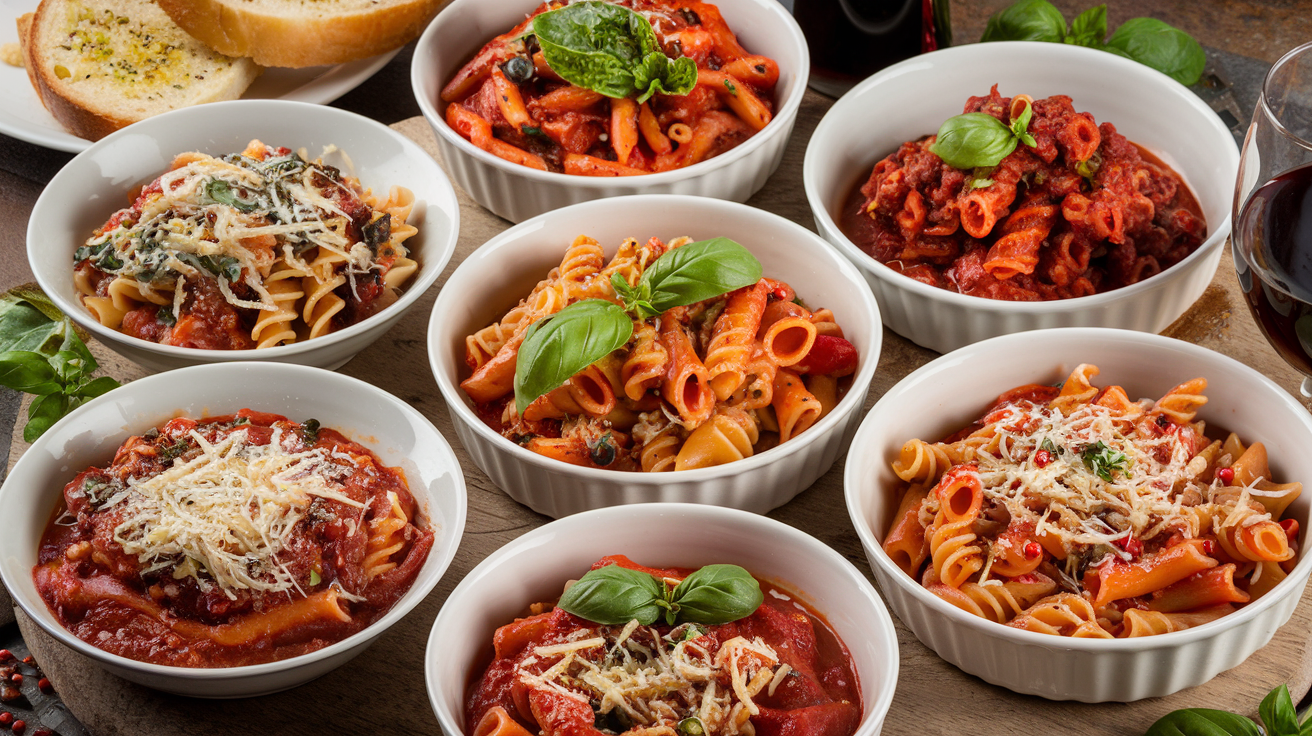
7 Fiery Spicy Pasta Dishes That Heat Seekers Will Love! 🌶️
If you’re a lover of bold flavors and enjoy a good fiery kick in your meals, spicy pasta dishes should be at the top of your list! Combining the comforting textures of pasta with the punch of heat, these dishes deliver a perfect blend of satisfaction and excitement. Whether you’re craving a classic Italian arrabbiata or something with a fusion twist like spicy Thai noodles, these pasta dishes will make you break a sweat in the most delightful way.
Let’s dive into some of the most tantalizing spicy pasta dishes that are sure to ignite your taste buds!
Why Spicy Pasta Dishes Are a Must-Try
Spicy pasta dishes combine the best of both worlds – the warmth and comfort of pasta, paired with the invigorating heat of spices and peppers. Not only do these dishes offer dynamic flavors, but the spice can also bring several health benefits. Capsaicin, the active component in chili peppers, is known to boost metabolism and enhance digestion. Plus, for those who enjoy the endorphin rush from spicy foods, these pasta dishes offer an ideal experience.
But the beauty of spicy pasta is how adaptable it is. Depending on your spice tolerance, you can adjust the heat level by adding more (or less) chili flakes, hot sauces, or spicy sausages. So, whether you’re a daring heat-seeker or just want a bit of a kick, there’s a spicy pasta dish for everyone.
Arrabbiata – The Classic Italian Spicy Pasta Dish
When we talk about spicy pasta dishes, arrabbiata always comes to mind. Originating from the Lazio region of Italy, this dish is made with simple, yet bold ingredients: tomatoes, garlic, and red chili peppers. The name “arrabbiata” translates to “angry” in Italian, reflecting the fiery heat of the sauce.
Ingredients:
- Penne pasta
- Tomatoes (fresh or canned)
- Garlic cloves
- Red chili flakes
- Olive oil
- Fresh basil
The sauce for arrabbiata is quick to prepare, but it’s the red chili peppers that steal the show, adding layers of heat and flavor to the dish. For a more intense kick, opt for crushed red pepper flakes or even fresh hot peppers. Don’t forget to garnish it with a bit of freshly grated Parmesan cheese and basil to balance the heat.
Spicy Cajun Pasta – A Southern Delight
Next on the list of must-try spicy pasta dishes is the crowd-pleasing Cajun pasta. This Southern-inspired dish brings a rich, smoky heat, thanks to the flavorful blend of Cajun spices. It usually includes chicken or shrimp, but you can easily make it vegetarian by adding bell peppers and mushrooms.
Ingredients:
- Fettuccine pasta
- Chicken or shrimp (optional)
- Bell peppers
- Cajun seasoning (a mix of paprika, cayenne, garlic powder, and thyme)
- Cream or milk
The secret to the perfect Cajun pasta lies in its spice mix. Cajun seasoning combines heat with aromatic spices, which create a robust, bold flavor profile. The creamy sauce mellows out the spiciness, making this a balanced yet exciting meal for any heat lover.
Spaghetti Aglio e Olio with Chili
For something simple yet incredibly flavorful, spaghetti aglio e olio with chili is a fantastic choice. This Italian classic usually calls for just olive oil, garlic, and parsley, but to give it that heat-seeker’s twist, adding chili flakes or fresh red chilies is key.
Ingredients:
- Spaghetti
- Olive oil
- Garlic cloves
- Red chili flakes or fresh chilies
- Fresh parsley
- Parmesan cheese (optional)
This dish allows the spicy element to shine, especially if you use fresh chilies. The oil absorbs the heat from the garlic and chili, creating a light yet potent sauce that clings perfectly to the spaghetti. For an added layer of flavor, you can sprinkle a bit of lemon zest on top to cut through the spice.
Spicy Thai Peanut Pasta
If you’re looking to explore global flavors in your spicy pasta dishes, try a spicy Thai peanut pasta. This dish features the unique combination of creamy peanut sauce, lime juice, and red chili paste, offering a rich, spicy, and tangy experience.
Ingredients:
- Rice noodles or linguine
- Peanut butter
- Soy sauce
- Red chili paste
- Lime juice
- Crushed peanuts
- Fresh cilantro
Thai red chili paste brings a fiery element to the dish, which is balanced by the creamy richness of peanut butter. Garnished with cilantro and crushed peanuts, this pasta dish delivers a zesty, spicy, and umami-packed flavor punch that heat seekers will love.
Spicy Pesto Pasta – A Twist on a Classic
For those who love basil pesto but crave a little more excitement, spicy pesto pasta is the perfect way to turn up the heat on this classic dish. By adding jalapeños or red chili flakes to traditional pesto, you can give your pasta a bold and fiery edge.
Ingredients:
- Fusilli or penne pasta
- Basil leaves
- Pine nuts or walnuts
- Olive oil
- Garlic cloves
- Parmesan cheese
- Jalapeños or red chili flakes
The spicy element cuts through the creaminess of the pesto, making each bite refreshing yet spicy. Serve it with grilled chicken or shrimp for a heartier meal, or keep it vegetarian by adding roasted vegetables.
Linguine Fra Diavolo – Devilishly Spicy Seafood Pasta
The name “fra diavolo” means “brother devil,” which already suggests the fiery nature of this spicy pasta dish. Often made with seafood like shrimp or lobster, this dish includes tomatoes, garlic, white wine, and, of course, plenty of red pepper flakes.
Ingredients:
- Linguine pasta
- Shrimp or lobster
- Crushed tomatoes
- White wine
- Garlic cloves
- Red pepper flakes
- Fresh parsley
The red pepper flakes create a punchy sauce that pairs beautifully with the sweetness of the seafood. For an even more intense heat, some cooks add extra fresh chilies. This dish is perfect for heat seekers who love seafood with their spice.
Chipotle Mac and Cheese – A Spicy Comfort Classic
Mac and cheese gets a spicy makeover with the addition of chipotle peppers, creating a creamy yet fiery version of this comfort classic. The smoky heat of chipotle pairs beautifully with the richness of the cheese sauce, making it an ideal dish for anyone who loves both creamy and spicy flavors.
Ingredients:
- Elbow macaroni
- Cheddar cheese
- Cream or milk
- Chipotle peppers in adobo sauce
- Butter
- Garlic powder
The chipotle peppers bring a unique smokiness and a steady burn that intensifies as you eat. If you’re feeling adventurous, you can even top it with crispy jalapeños or hot sauce for an extra kick.
FAQs
What is the best pasta to use for spicy dishes?
The best pasta for spicy dishes often depends on the sauce. Penne or rigatoni is great for thicker sauces like arrabbiata, while spaghetti works well with lighter sauces like aglio e olio.
How can I make my pasta less spicy if it’s too hot?
If you’ve overdone the heat, balance the spice by adding dairy (cream, milk, or cheese), which neutralizes some of the capsaicin, the compound responsible for the heat in chili peppers.
Can I adjust the spiciness in these recipes?
Absolutely! You can always adjust the level of heat by adding more or less chili flakes, hot sauce, or fresh peppers to suit your tolerance.
What can I serve with spicy pasta dishes?
Spicy pasta pairs well with cooling side dishes like a fresh green salad, garlic bread, or even yogurt-based dips like tzatziki to help balance the heat.
Is spicy food healthy?
Spicy foods have health benefits! They can boost metabolism, improve digestion, and even release endorphins, which can enhance your mood.
What’s the best way to store leftovers of spicy pasta dishes?
Store leftovers in an airtight container in the fridge for up to 3 days. The flavors, including the spiciness, often intensify over time!
With these spicy pasta dishes, you can take your taste buds on a thrilling ride! Whether you prefer the bold heat of Cajun pasta or the classic punch of arrabbiata, there’s a dish here for every level of spice lover. Ready to spice up your pasta game? Check out even more fiery recipes and tips at Foodies Den.
-
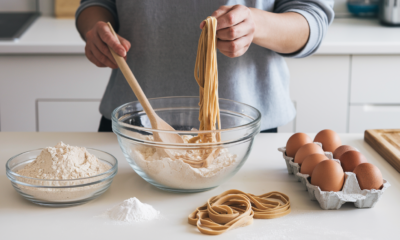
 Pasta Recipes10 months ago
Pasta Recipes10 months agoHow to Make Delicious Gluten Free Pasta at home
-
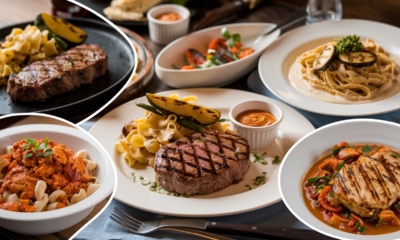
 Pasta Recipes10 months ago
Pasta Recipes10 months ago5 Delicious Steak and Pasta Recipes
-
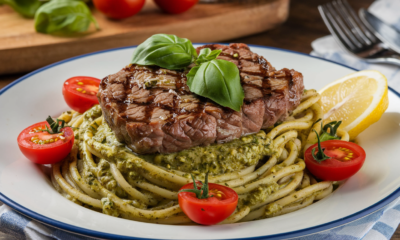
 Pasta Recipes10 months ago
Pasta Recipes10 months agoDelicious & Delightful Steak and Pesto Linguine Recipe
-
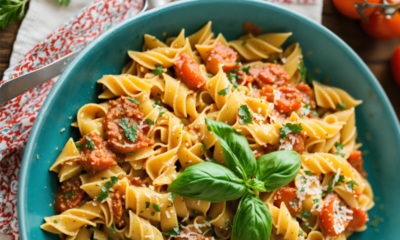
 Pasta Recipes9 months ago
Pasta Recipes9 months agoSwirly Pasta Recipe: Creative, Fun, and Delicious
-
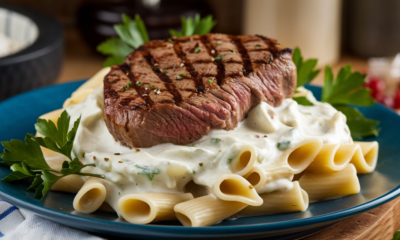
 Pasta Recipes10 months ago
Pasta Recipes10 months agoDelicious & Creamy Steak Alfredo Recipe
-

 Pasta Recipes9 months ago
Pasta Recipes9 months agoBrown Rice Pasta Recipe: A Healthy, Gluten-Free Alternative
-
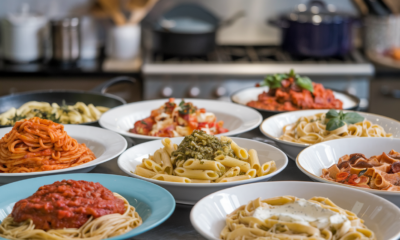
 Pasta Recipes10 months ago
Pasta Recipes10 months ago10 Easy Pasta Recipes for Busy Weeknights
-

 Pasta Recipes9 months ago
Pasta Recipes9 months agoSacchetti Pasta Recipe: Little Pouches of Flavor to Impress






